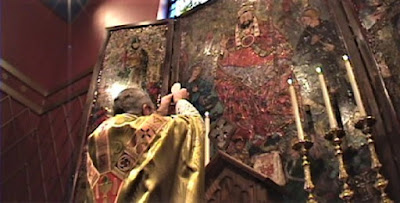Peter was orphaned when he was very young child, and had the misfortune of being taken in by one of his older brothers who was very cruel to him. Another brother named Damian, who was a priest, saw this unjust treatment, and so took Peter into his own house, and cared for him. Peter was so grateful to this brother’s kindness that he added his name to his own, and was forevermore known as Peter Damian. Because of the previous ill-treatment, Peter Damian was always very good to the poor. It was quite usual for him to invite the poor to eat with him, and he would care personally for them their needs. Also, because of his brother’s generosity to him, Peter Damian was able to receive an excellent education, and eventually became a university professor in Ravenna.
From early in his life Peter Damian was very strict with himself. He wore a hair shirt under his clothes, he fasted, and he spent many hours in prayer. Soon he decided to leave his teaching and give himself completely to prayer with the Benedictines. Peter Damian was so eager to pray, and he slept so little, that it began to take a toll on his health, and the other monks warned him to use some prudence in taking care of himself.
When his abbot died, Peter Damian was chosen to take his place, and subsequently founded five more monasteries. He encouraged his brothers in a life of prayer and solitude and wanted nothing more for himself. The Holy See periodically called on him, however, to be a mediator in various disputes that might arise, or if some cleric or government official had a disagreement with Rome.
Eventually Pope Stephen IX made Peter the cardinal-bishop of Ostia. He worked hard to bring about much-needed reform, by encouraging his priests to lead chaste and holy lives, and to maintain scheduled prayer and proper religious observance. He sought to restore discipline among religious and priests, warning them against excessive travel and too comfortable living. He concerned himself with what might seem to be small details – for instance, he once wrote to a bishop to point out that his clergy were sitting down for the psalms in the Divine Office – but he knew that care in small things would lead to carefulness in more important things.
He was eventually allowed to retire as cardinal-bishop of Ostia, and he was happy to become once again a simple monk, but he was still called to serve as a papal mediator from time to time. It was when returning from such an assignment in Ravenna that he was developed a fever. With the monks gathered around him saying the Divine Office, he died on February 22, 1072. In 1828 he was declared a Doctor of the Church.
Grant, we beseech thee, Almighty God: that we may so follow the teaching and example of thy blessed Confessor and Bishop, St. Peter Damian; that learning of him to despise all things earthly, we may attain in the end to everlasting felicity; Through Jesus Christ thy Son our Lord, who liveth and reigneth with thee in the unity of the Holy Ghost, ever one God, world without end. Amen.














